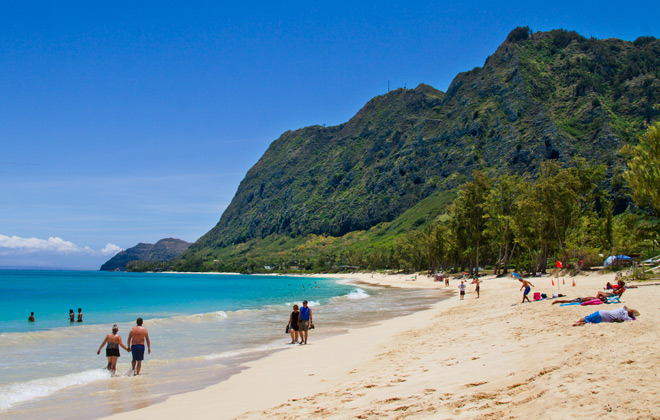Waimanalo residents have mixed feelings on No. 1 beach rank

Waimanalo Bay Beach Park was named the No. 1 beach in the nation in an annual top 10 listing of U.S. beaches compiled by a Florida professor known as Dr. Beach.
Many small-town residents would get a kick out of their communities being recognized like Waimanalo recently was when one of its beaches was ranked No. 1 in the U.S. But here, pride was mixed with apprehension about visitors.
"My first reaction was ‘oh no,’" said Dean Okimoto, founder of Nalo Farms. "It is beautiful and everything, but yeah, I was thinking OK weekends — my goodness."
Just 4.35 square miles on Oahu’s windward coast, about 65 percent of people in Waimanalo are Native Hawaiian — the second-highest concentration on the island. There’s a scattering of businesses, some horse stables and farms, one supermarket and a main highway with one lane in each direction that’s become increasingly congested over the past decade.
Waimanalo Bay Beach Park — with its powdery sand, turquoise water, cleanliness and convenient amenities — was named the best beach last month on an annual top 10 list compiled by a coastal science professor known as Dr. Beach. And some say the number of visitors has already picked up.
Stephen Leatherman, who teaches at Florida International University, said he was worried about the reaction to his list. "It’s kind of small, Hawaiian locals mostly live there," he said. "People will say, ‘oh this is our secret beach.’"
Sure enough, placing Waimanalo Bay in the top spot led to the most hate mail he’s received. "You know what you’re doing? You’re messing up this beautiful Hawaiian place," he said was the sentiment of about a dozen angry emails.
Don't miss out on what's happening!
Stay in touch with breaking news, as it happens, conveniently in your email inbox. It's FREE!
"It’s a beautiful place— we want to tell everyone about it. But how do we retain the small-town feel and culture of Waimanalo that’s so rooted in Native Hawaiian culture and practices," said Randi Song, spokeswoman for the Waimanalo Health Center, in summing up the range of emotions felt by the beach distinction.
Beach visitors increased within a few days of the list’s release, lifeguard David Loganbill said. "It was an immediate impact, for sure," he said. "People even telling us, ‘We heard this is the No. 1 beach in the nation.’ They came looking for it." He estimates that weekday visits to the beach have doubled.
Beaches that make it to the top spot typically see tourism increase by 10 to 20 percent, Leatherman said.
Some Waimanalo residents are banking on that.
Keoki Emond, owner of Ono Steaks and Shrimp Shack, is hopeful the Dr. Beach list will do for Waimanalo what it did for Kailua, which saw an increase in business when it made the top spot in 1998. Emond, who is Native Hawaiian and a lifelong Waimanalo resident, knows that not everyone sees that as a good thing. Change has been coming to Waimanalo despite the list, he said.
"You can’t stop the growth, no matter what we try to do," he said, adding that Waimanalo’s small size will prevent overdevelopment.
The restaurant started out as a lunch wagon, with customers being 75 percent local. Now it’s an even mix of tourists and locals. "The local people will make business last, but the tourists make business boom," he said.
Sunya Nardo doesn’t want to see Waimanalo turn into Kailua.
"Not that long ago they were the No. 1 beach and they got bombarded with tourists," she said, watching from her front yard as tour busses whizzed along Kalanianaole Highway. "Waimanalo is country. We just want to leave it like that."
Waimanalo Neighborhood Board Chairman Wilson Ho joked about telling outsiders, "the people are terrible, the water is not so good." But the truth is, "all our lives, we knew this was the most amazing beach," said Ho, who lives on Hawaiian homestead land across Waimanalo Beach Park. "It is what it is. It’s nothing you can push away."
There’s concern that Waimanalo’s size can’t accommodate an increase in tourists. Even before the list came out, there were instances of tour busses pulling into the tiny health center’s lot, taking up patient stalls to marvel at native plants, Song said. Busloads of tourists taking pictures along the highway’s median can be dangerous for them, and lifeguards might become overwhelmed by visitors unfamiliar with the power of the ocean, said Waimanalo resident Louana Kassebeer, whose family has lived on a Hawaiian homestead lot for five generations.
But Kassebeer said the concerns shouldn’t deprive Waimanalo of its rightful spot at the top of the beach list.
"I felt so proud," she said. "The beach made me what I am today. … My front yard was the beach and the Koolau mountains was my backyard."
For her, it’s more than a recreation spot —it’s a place to go fishing or scatter ashes of loved ones.
"It just has this soothing view," she said. "All you see is blue. It just humbles you."





